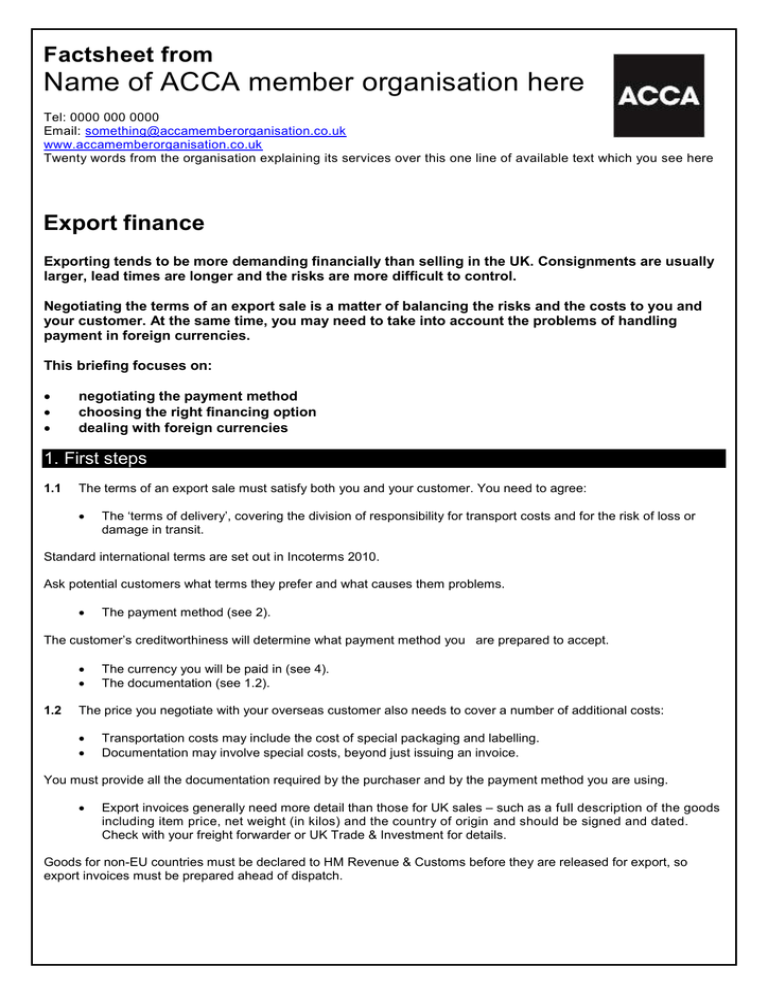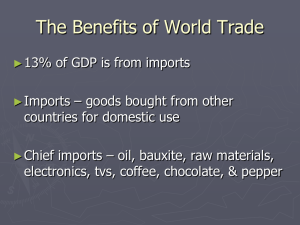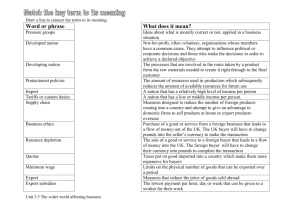
Factsheet from
Name of ACCA member organisation here
Tel: 0000 000 0000
Email: something@accamemberorganisation.co.uk
www.accamemberorganisation.co.uk
Twenty words from the organisation explaining its services over this one line of available text which you see here
Export finance
Exporting tends to be more demanding financially than selling in the UK. Consignments are usually
larger, lead times are longer and the risks are more difficult to control.
Negotiating the terms of an export sale is a matter of balancing the risks and the costs to you and
your customer. At the same time, you may need to take into account the problems of handling
payment in foreign currencies.
This briefing focuses on:
negotiating the payment method
choosing the right financing option
dealing with foreign currencies
1. First steps
1.1
The terms of an export sale must satisfy both you and your customer. You need to agree:
The ‘terms of delivery’, covering the division of responsibility for transport costs and for the risk of loss or
damage in transit.
Standard international terms are set out in Incoterms 2010.
Ask potential customers what terms they prefer and what causes them problems.
The payment method (see 2).
The customer’s creditworthiness will determine what payment method you are prepared to accept.
1.2
The currency you will be paid in (see 4).
The documentation (see 1.2).
The price you negotiate with your overseas customer also needs to cover a number of additional costs:
Transportation costs may include the cost of special packaging and labelling.
Documentation may involve special costs, beyond just issuing an invoice.
You must provide all the documentation required by the purchaser and by the payment method you are using.
Export invoices generally need more detail than those for UK sales – such as a full description of the goods
including item price, net weight (in kilos) and the country of origin and should be signed and dated.
Check with your freight forwarder or UK Trade & Investment for details.
Goods for non-EU countries must be declared to HM Revenue & Customs before they are released for export, so
export invoices must be prepared ahead of dispatch.
Insurance of the goods is your responsibility, and the cost of any credit insurance you purchase must be
taken into account.
Financing and transaction costs will include the cost of financing the transaction until you receive payment,
and any costs of foreign exchange, payment collection and documentation.
2. Payment methods
The payment method you use has a significant effect on the financing you require and the level of risk to which you are
exposed.
2.1
Open account payment is similar to offering credit to a UK customer.
Typically, the credit term (eg 30 days) starts once you despatch and invoice for the goods, in line with the terms of
trade.
You bear all the risks of offering credit, just as for a sale in the UK.
You need to arrange finance to fund the whole of the transaction.
There are no extra costs, other than those involved in any export transaction (see 1).
Open account payment is typically used for exports within the EU and export sales to customers with whom you have
an established relationship.
2.2
A documentary collection, where you draw up a bill of exchange, allows you to keep control of the goods and
raise additional finance.
An overseas bank, acting on your bank’s behalf, will only release the documents necessary for your customer to take
possession of the goods once they formally accept the terms of the bill.
There is a risk that the bill of exchange will not be accepted.
You still have ownership and control of the goods, but in your customer’s country.
There is still a risk that you will not receive payment, unless the bill has been guaranteed by the bank
(‘avalised’).
You will have a strong basis for pursuing legal action against the customer.
The bill of exchange specifies any credit period you are offering.
You can specify immediate payment, payment after a set number of days, or payment by a given date.
Once the bill has been accepted, you can use the bill of exchange to raise additional finance (see 3.2 and
3.3).
Both your bank and the overseas bank will charge a commission.
Your terms of trade must specify who is responsible for paying these charges.
Documentary collections are typically used for exports outside the EU to customers you have an established
relationship with.
2.3
Documentary credits (or ‘letters of credit’) are the most secure method of payment (other than payment in
advance).
Your customer arranges a letter of credit with their bank (the ‘issuing bank’) which pays a correspondent bank in the
UK (the ‘advising bank’), once you submit all the necessary documentation.
An accurate and authentic ‘irrevocable’ letter of credit, verified by your bank, carries little credit risk.
2
As long as your documents are accurate, the issuing bank guarantees to pay you within the stipulated time.
By ‘confirming’ the letter of credit, your bank agrees to pay you if the issuing bank defaults. Your bank will
charge a commission based on how creditworthy the issuing bank is.
The letter of credit specifies any credit period you are offering.
A ‘term’ credit, where payment is made after a set term (eg 30 days), will require you to finance the gap between
delivery and payment.
You can use a valid, current letter of credit to raise additional finance in a similar way to using a bill of
exchange (see 3.2 and 3.3).
Your customer is responsible for the cost of issuing the letter of credit.
The customer will want to pass these costs on to you as part of the price negotiation.
Documentary credits are typically used for exports to customers you have not sold to before, and for customers and
countries that present particular credit risks.
2.4
You may be able to negotiate payment in advance for all or part of the shipment.
You have no risks and bear none of the financing costs.
There is no additional cost to you beyond the costs involved in any export transaction (see 1).
Payment or part payment in advance is typically used for low value sales to individuals or new customers.
For any individual transaction, the most appropriate method will depend on the level of risk involved, how strong your
negotiating position is, and how the cost of financing compares for you and your customer.
3. Financing options
Unless you have negotiated payment in advance, exporting may require additional financing.
While you may be able to use a standard loan or overdraft facility, other options can be more cost effective and provide
access to greater amounts of working capital.
3.1
You can arrange a foreign currency loan or overdraft to borrow the amount of foreign currency you expect to be
paid.
You may be able to use proof of the export sale as security for the borrowing.
Your bank may only accept this form of security if it has approved the customer, or if you purchase credit insurance.
You exchange the money you borrow into pounds to use as working capital.
You repay the borrowing with the payment you receive from your customer.
If the customer fails to pay, you will be exposed to the additional risk that the exchange rate has moved against you.
3.2
You can sell a negotiable bill of exchange that has been accepted by the drawee (eg your customer).
Your bank (or another financial institution) buys the bill from you for a discounted value. The amount the bank pays
depends on the currency, amount and term of the bill and the creditworthiness of the drawee.
If the drawee is not known to your bank as creditworthy, the bill will have to be endorsed (ie guaranteed) by a
third party — typically the customer’s bank or a government agency.
The third party will usually charge for this.
3
The effective interest rate your bank charges on the financing will include a margin over interbank interest
rates for that term in that currency.
Typically, the margin for a bill that has been accepted by a high quality drawee (eg a major bank) will be 1-3%.
The amount you sell the bill for will be paid to you in the currency the bill is denominated in.
You can convert the proceeds (see 4.2).
3.3
You can use a bill to arrange additional borrowing. It acts as security for a bank loan or overdraft facility.
This financing can be arranged on a ‘recourse’ or ‘non-recourse’ basis.
With ‘recourse’ financing, you have to repay your bank if the customer does not make the payment required
by the bill.
‘Non-recourse’ financing will only be available if the bill has been accepted or guaranteed by an institution
that is acceptable to your bank.
Typically, this would be a major bank or a creditworthy government.
3.4
Forfaiting enables you to raise money on major transactions where you will be paid in stages over a longer
period. You draw up a series of bills of exchange with different terms and can then negotiate them all at once.
3.5
Forfaiting is usually used to finance high-value goods, such as construction projects.
An export factor, specialising in collecting payments from overseas, can usually lend you more against an invoice
than a bank.
Export factoring provides up to 80% of the value of each invoice once you issue it.
You receive the balance upon settlement.
Export factoring is generally only available for sales to countries where your annual exports are at least
£100,000.
The finance cost is usually 1-3% above a standard rate for an overdraft.
Each financing option, whether in pounds or a foreign currency, has different costs and cashflow implications. Explore
your financing options before agreeing your terms.
4. Foreign currencies
Most customers will prefer you to quote and invoice them in their local currencies, rather than pounds. Unless you are
prepared to do so, they may choose alternative suppliers. However, invoicing in a foreign currency exposes you to
additional risks and costs.
4.1
You have a foreign exchange risk for any amounts you hold or expect to receive in a foreign currency.
4.2
You are particularly at risk if the foreign currency is volatile or chronically weak, for example, in some middle
Eastern or African currencies.
Some currencies present extra difficulties.
You will need a foreign currency bank account (see 4.5) to hold the funds until you convert them to pounds.
There will be an extra transaction cost and delay for converting the foreign currency into pounds. With a ‘spot’
foreign exchange transaction, you sell a bank foreign currency in return for pounds.
The cost of the transaction will be included in the rate you are quoted.
For a £100,000 transaction in a widely traded currency (eg US dollars), the effective cost might be 0.1-0.5% .
4
4.3
A spot transaction usually takes effect two days after you agree the transaction price.
You can hedge against the risk of adverse exchange rate movements by using a forward foreign exchange
contract. You agree to sell the bank the foreign currency at a fixed future date for a price that is set now.
The difference between the spot exchange rate and the forward exchange rate will reflect relative interest
rates between the two currencies.
The effective transaction cost of a forward contract is typically 0.2-0.6%.
You must fulfil the forward contract, even if your customer does not pay you.
You will then be at risk for any adverse movement in the currency.
4.4
You can buy an option to sell the foreign currency. This gives you the right, but not the obligation, to sell the
foreign currency at an agreed rate on the specified date.
If exchange rates move against you, you use the option; if they move in your favour, you allow the option to
lapse.
You pay a premium for the option, which depends on the volatility of the currencies involved, relative interest
rates and how far into the future the option covers you.
A three-month option on a specific forward exchange rate might typically cost you 2-5% .
4.5
It may be more convenient to maintain foreign currency accounts if you frequently issue foreign currency
invoices.
You will receive interest on the balance in each foreign currency account.
For amounts less than the equivalent of £100,000, the interest rate is likely to be substantially below the interbank rate.
You can convert foreign balances into pounds sterling when you choose.
Fewer, larger transactions will be cheaper and involve less administration than converting every payment received.
It can be useful to have a foreign currency account for any payments you need to make in that currency.
Bills of exchange
A.
A bill of exchange is a written document in which ‘the drawer’ requires ‘the drawee’ to pay a specified amount.
The drawer is yourself.
The drawee is usually your customer.
If a bill is being used with a term letter of credit (see 2.3), the drawee is usually the customer’s bank.
B.
The bill will also specify when payment should be made.
The bill can request immediate payment (‘at sight’ or ‘on demand’) or payment at a later date (‘the term’), eg
30 days after sight.
New exporters may find that their bank is not initially willing to provide them with term bills.
C.
Drawees become legally liable for payment once they ‘accept’ (agree to pay) the bill.
D.
A bill is often referred to as a ‘draft’ until it has been accepted.
‘Negotiable’ bills specify payment ‘to the order of’ the drawer.
5
This allows you to negotiate the bill, ie to sell it to another party (usually your bank) to raise finance (see 3.2).
Note
INCOTERMS 2010 is available from the International Chamber of Commerce (www.iccwbo.org).
Note
Export procedures, payments and documentation can be complicated. Contact your bank or UK Trade & Investment
(www.ukti.gov.uk; 020 7215 5000) for help and advice.
Last reviewed 01.10.12
© BHP Information Solutions 2012. ISSN 1369-1996. All rights reserved. No part of this publication may be reproduced or transmitted without the
written permission of the publisher. This publication is for general guidance only. The publisher, expert contributors and distributor disclaim all liability
for any errors or omissions. Consult your local business support organisation or your professional adviser for help and advice.
6







